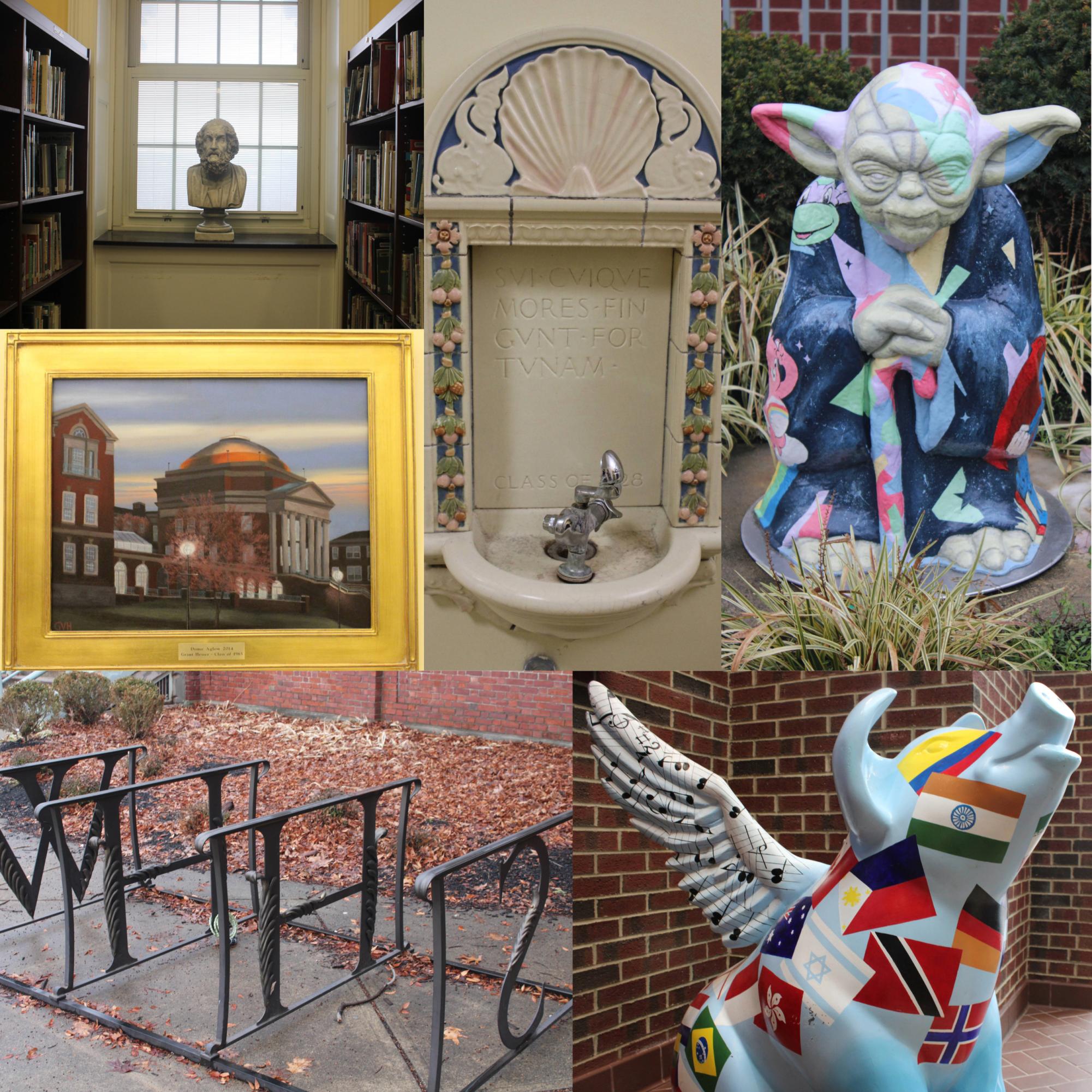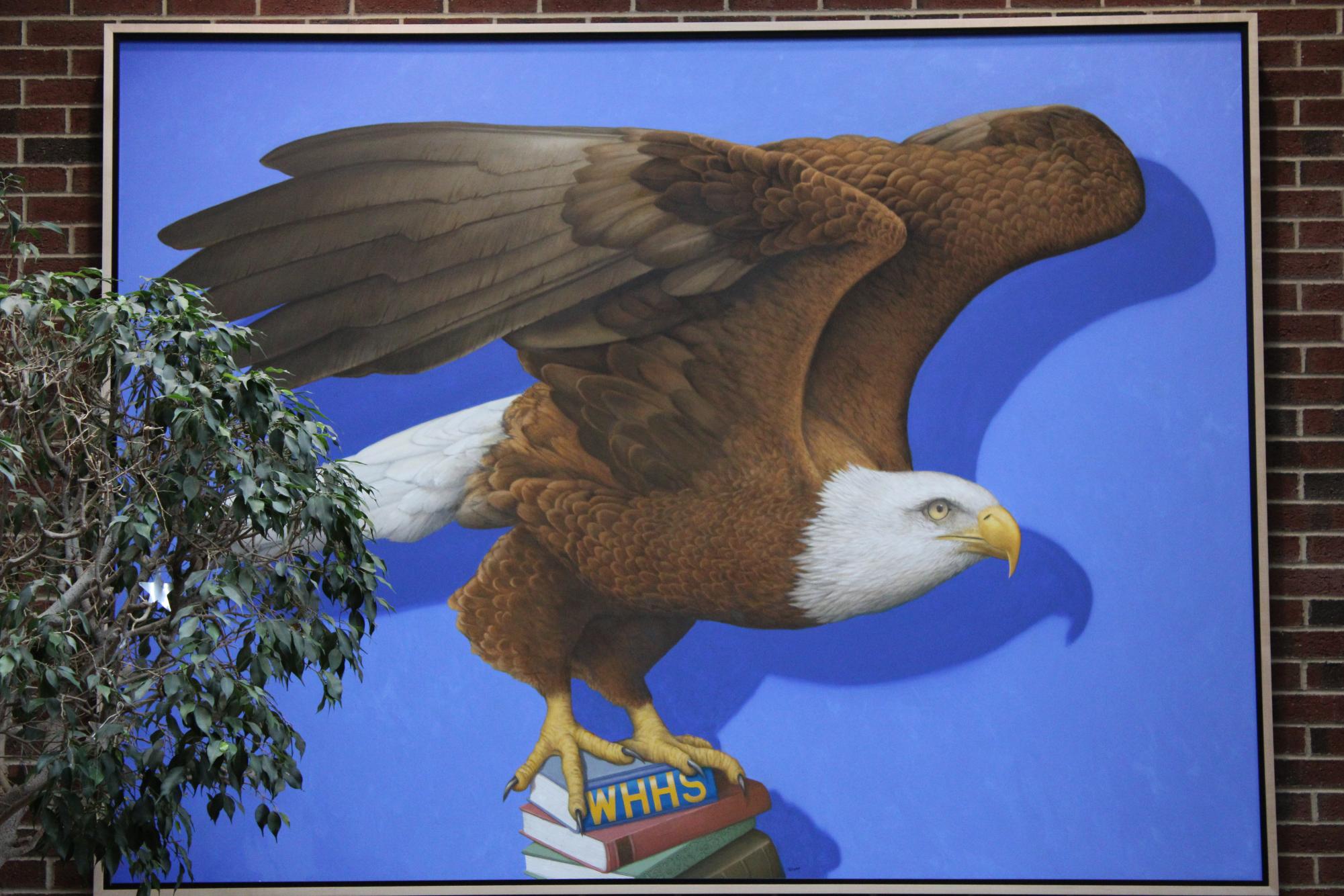Students walk the same routes through the hallways hundreds of times as they go from class to class; however, in their rush many don’t notice the incredible art and architecture that surrounds them on a daily basis.
“I just feel like art adds a lot. [It’s just that] kids don’t know anything else. If you go to other schools, they don’t have fine art like that, just in the halls,” Debbie Heldman, executive director of the Alumni Foundation, said. “The new schools are all modern cinder blocks. We have depth.”
One recent piece of art that many may have noticed, but do not know the story behind, is the striking cobalt blue painting of an eagle that watches over passing students in the arcade. The eagle was a gift from renowned nature artist Tom Palmore, who originally toured WHHS with his partner, an alum. While Palmore never attended WHHS, during the tour he was very impressed with the school, sparking his creativity.
“[Palmore] said, ‘Well, how about I paint you an eagle?’… Fast forward to right before COVID [and] I hadn’t heard from him. Then I get this email: ‘Hi Debbie, we’re shipping you the painting,’” Heldman said. “I open [it] up and I’m like, ‘Oh my god. This is an oil painting of an eagle.’”
Palmore studied at the Pennsylvania Academy of Fine Arts in Philadelphia and is known for his attention to detail, capturing animals in almost photographic realism as featured in his book “Earthlings: The Paintings of Tom Palmore.”
“My paintings are about other earthlings that we share this planet with… and about our relationship with them,” Palmore said.

Another vibrant piece in the arcade is the iconic lifesize blue pig covered in drawings of flags. The pig is from a former Cincinnati event called the ‘Big Pig Gig,’ in which local artists and schools decorated more than 400 pigs and placed them around the city. The event took place in the summer of 2000 and brought in an estimate of $170 million from tourists eager to see the namesakes of ‘Porkopolis’.
A vast majority of the art around WHHS was funded or created by alums. Two examples of this are the four oil paintings of WHHS in the front hall by the Blair entrance, which were painted by Grant Hesser, ‘65, and the metal WHHS bike rack, which was made by an alum with a passion for welding.
“When we have reunions here, [the] class looks at a wishlist of things that I’ve come up with and [decides what to] raise money for,” Heldman said. “That’s how we get things like student travel, the bicycle rack, the Veterans Memorial, all the art benches, the wood benches, if you look at the end it says class of 1963. These are all gifts, things that I’ve come up with to enhance the facility.”
Other interesting art pieces include the Rookwood Pottery water fountains in the main hallway next to the auditorium, which were gifted to the school by the class of 1929. In addition to this, Rookwood tiles also line the library ceiling, depicting Nimrud from the ancient Assyrian Empire.
Directly across from the Rookwood fountains sits a more hidden treasure. In room 2301, nine murals by esteemed artist Paul Ashbrook line the walls. Ashbrook’s wife was a French teacher at WHHS from 1922 until her retirement in 1949. According to the book “An Expression of the Community: Cincinnati Public Schools’ Legacy of Art and Architecture,” they depict French provinces and were presented to the school in 1943.
“Because of the murals, this classroom still has high ceilings, but other classrooms do not,” Dawn Wolfe, the English teacher who teaches alongside the murals, said. “Even my projector is anchored differently, [and] I have heating and cooling that is different from [other classrooms] because of the murals. They had to make some adjustments because we couldn’t mess this up.”
Only one of the murals is al fresco, meaning it was painted directly onto the wall. The remaining eight paintings were done on panels that Ashbrook did in his studio, allowing them to be removed from the wall.

(Elena Brown)
“These were all taken down and professionally cleaned and stored while the renovation was going on,” Wolfe said. “Then they came back in and they were putting them back up days before we moved back in. I was working in here in a hardhat while they were trying to finish up the room.”
For Wolfe and many others, the challenges that come along with preserving the art around the building are greatly overshadowed by their aesthetic and historical appeal.
“It is an honor to be able to teach in a work of art every single day,” Wolfe said. “It’s amazing that we have this piece of history. We are so lucky to have the Rookwood [artwork] and the different architectural design that makes our building distinctly different from other schools; even the paintings that we have, the statues. What you all get to learn in is amazing, [and] I’m glad that you’re able to do so.”





